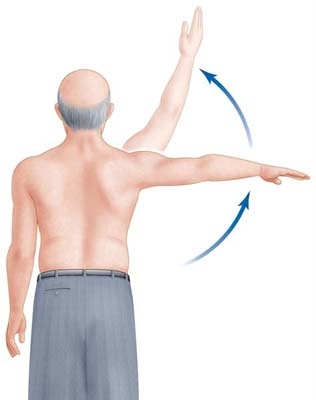Test Item Cluster - Full-Thickness Rotator Cuff Tear
Original Editor - Jun Cesar Atienza
Lead Editors - Your name will be added here if you are a lead editor on this page. Read more.
Purpose
[edit | edit source]
To test the presence of a shoulder full-thickness rotator cuff tear using the The Drop-Arm Sign, The Painful Arc Sign, and the Infraspinatus Muscle Test.
Evidence[edit | edit source]
Based on the Park et al[1] study, the combination of the following 3 special tests have produced the highest post-test probability to diagnose a full-thickness rotator cuff tear:
- The Drop-Arm Sign
- The Painful Arc Sign
- Infraspinatus Muscle Test
The study concluded that if all 3 tests were positive, the probabibility of the patient having a full-thickness rotator cuff tear is 91%.[1]
Description and Illustrations
[edit | edit source]
The Drop-Arm Sign
Patient actively elevates the arm in the scapular plane and then slowly reverses the motion. A positive test is defined as the patient experiencing pain during the activity or that the arm suddenly drops.
The Painful Arc Sign (Fig 1)
Patient fully elevates the arm along the scapular plane and then slowly reverses the motion. If patient experiences pain between 60° and 120° of range of motion, the test is considered positive.
Figure 1 (couresty of http://www.maitrise-orthop.com)
Infraspinatus Muscle Test (Fig 2)
Arm is resting in neutral, the patient is instructed to flex elbow to 90° and resist against applied resistance mediall. If the patient is unable to resist the force or experiences pain, the test is considered positive.
Figure 2 (taken directly from Park et al[1])
References[edit | edit source]
- Park HB, Yokota A, Gill HS, El RG, McFarland EG. Diagnostic accuracy of clinical tests for the different degrees of subacromial impingement syndrome. J Bone Joint Surg Am 2005 July;87(7):1446-55. www.jbjs.org/Comments/pdf/JBJA087071446.pdf
- ↑ 1.0 1.1 1.2 Park HB, Yokota A, Gill HS, El RG, McFarland EG. Diagnostic accuracy of clinical tests for the different degrees of subacromial impingement syndrome. J Bone Joint Surg AmfckLR2005 July;87(7):1446-55. Cite error: Invalid
<ref>tag; name "Park" defined multiple times with different content Cite error: Invalid<ref>tag; name "Park" defined multiple times with different content








